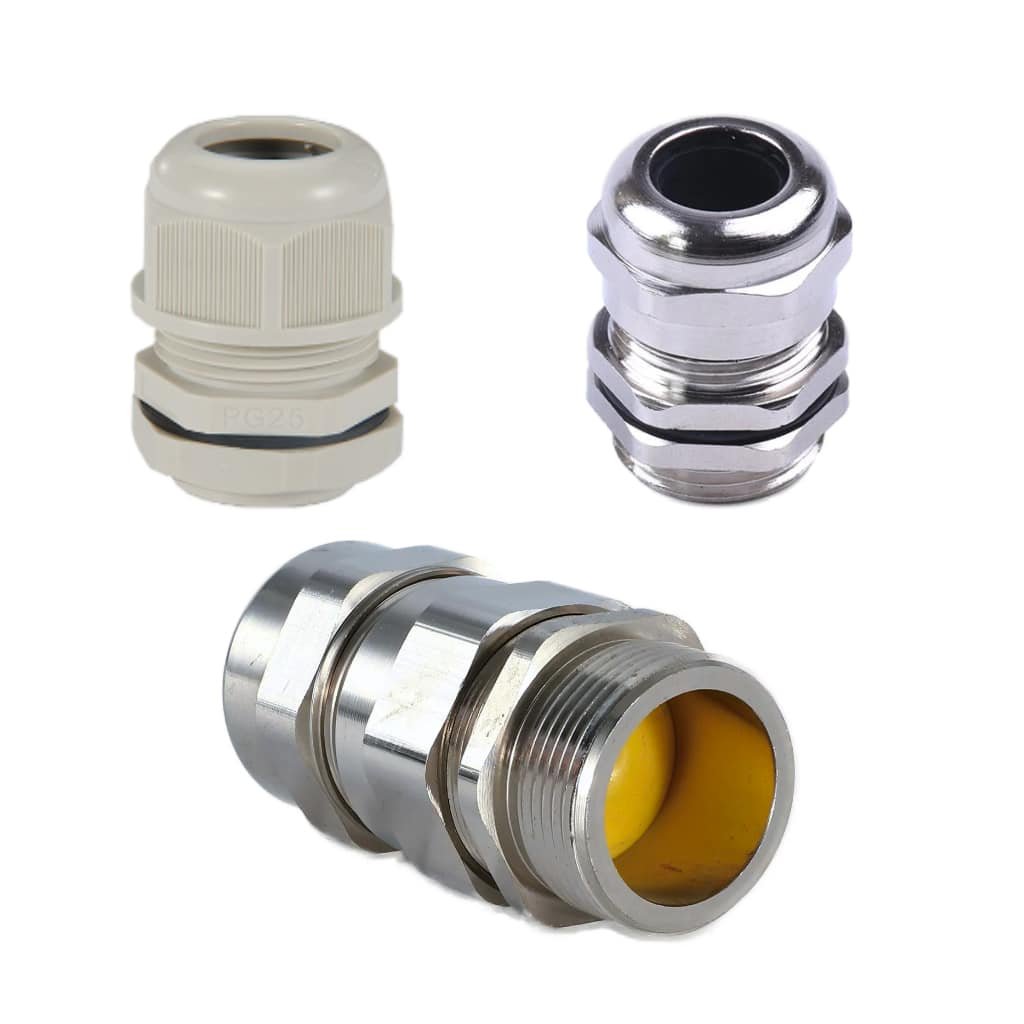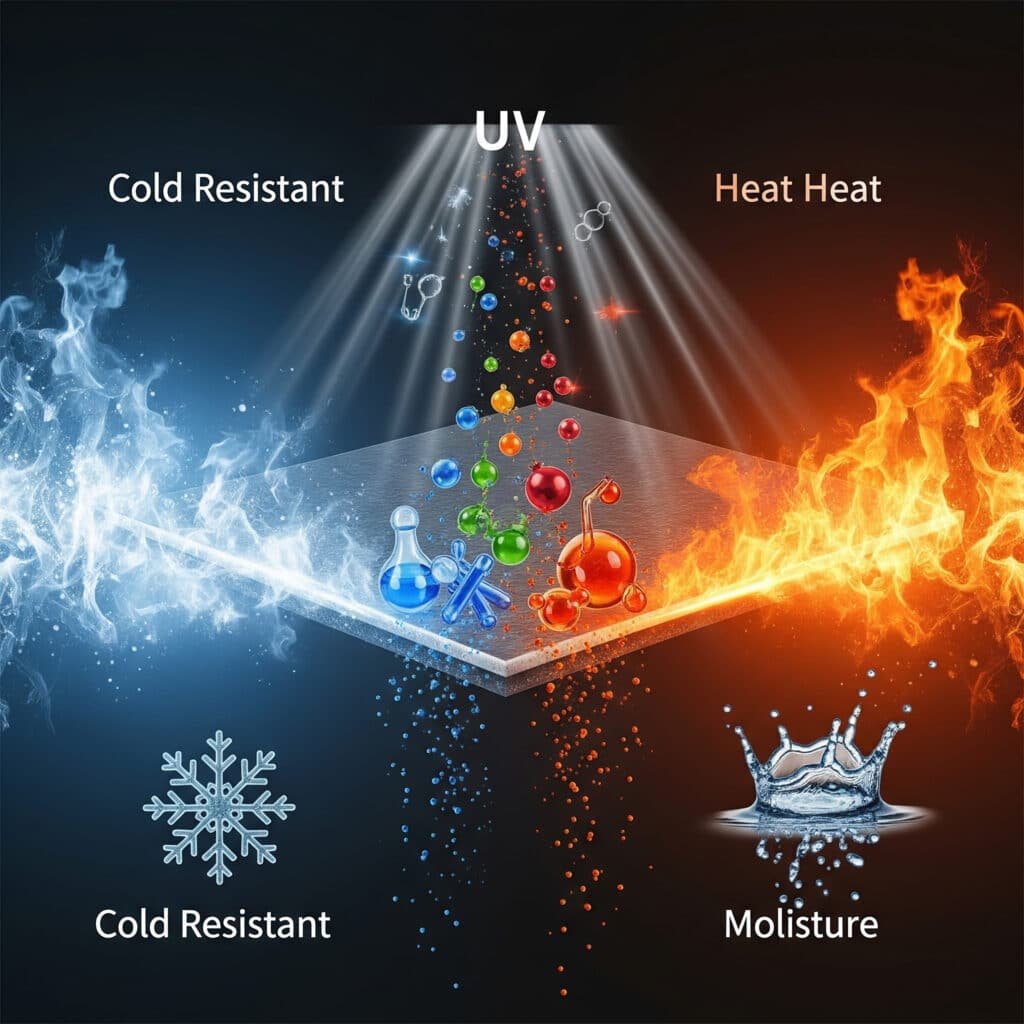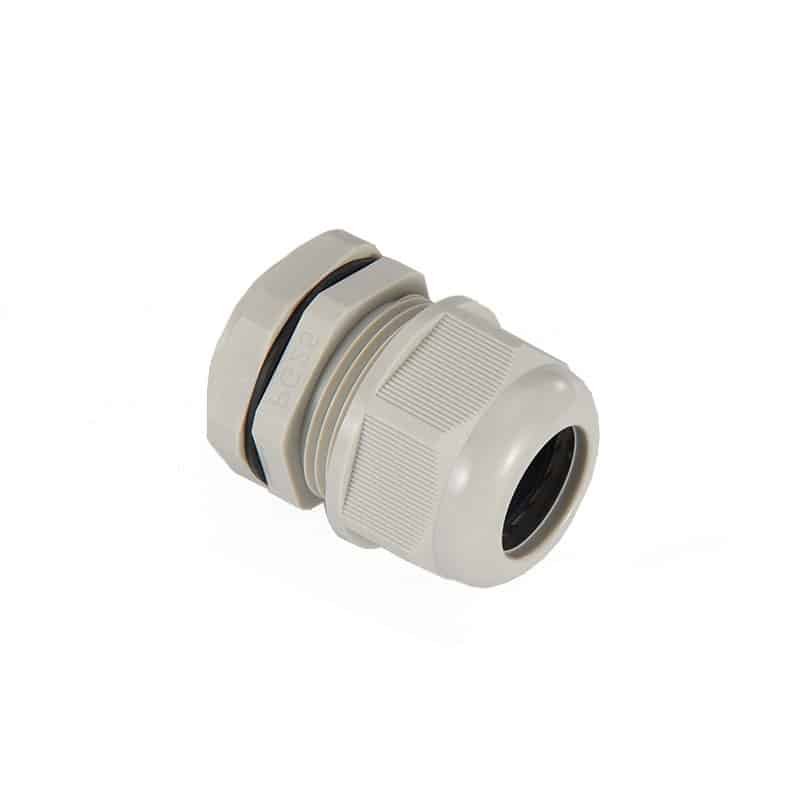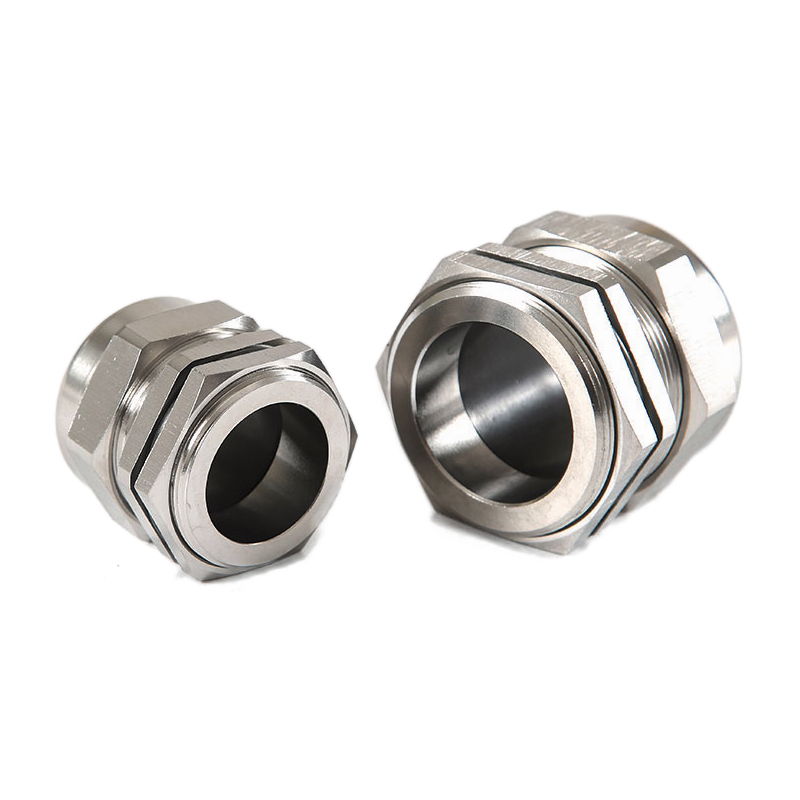
Choosing the wrong cable gland material can lead to premature failure, safety hazards, and costly replacements. Material selection isn’t just about cost – it’s about performance.
Cable gland materials include nylon for cost-effective general use, brass for EMC shielding and durability, stainless steel for corrosive environments, and aluminum for lightweight applications requiring excellent conductivity.
Last month, I helped Hassan replace 200 brass glands in his chemical plant because they corroded within six months. The right material choice from the start would have saved him $15,000. 😉
Table of Contents
- What are the main cable gland materials and their properties?
- How do environmental conditions affect material selection?
- Which material offers the best value for different applications?
- What are the latest innovations in cable gland materials?
What are the main cable gland materials and their properties?
Understanding material properties is crucial – each material has its sweet spot where it performs exceptionally well.
The four primary cable gland materials are nylon (PA66) for general applications, brass for EMC and durability, stainless steel for corrosion resistance, and aluminum for lightweight strength.
Comprehensive Material Comparison
Nylon (PA66) Cable Glands
| Property | Performance | Rating |
|---|---|---|
| Temperature Range | -40°C to +100°C | ⭐⭐⭐⭐ |
| Chemical Resistance | Good to most chemicals | ⭐⭐⭐ |
| UV Resistance | Moderate (with additives) | ⭐⭐⭐ |
| Cost Effectiveness | Excellent | ⭐⭐⭐⭐⭐ |
| Weight | Very light | ⭐⭐⭐⭐⭐ |
Key Advantages:
- Excellent insulation properties
- Resistant to most oils and solvents
- Self-extinguishing (UL94-V21)
- Easy to machine and modify
Limitations:
- Not suitable for high-temperature applications
- Can become brittle in extreme cold
- Limited EMC shielding capability
Brass Cable Glands
| Property | Performance | Rating |
|---|---|---|
| Temperature Range | -40°C to +120°C | ⭐⭐⭐⭐ |
| EMC Shielding2 | Excellent | ⭐⭐⭐⭐⭐ |
| Mechanical Strength | Very good | ⭐⭐⭐⭐ |
| Corrosion Resistance | Moderate | ⭐⭐⭐ |
| Cost | Moderate | ⭐⭐⭐ |
David, our German purchasing manager, always specifies brass glands for industrial automation equipment. “The EMC shielding is worth every euro,” he says. “We’ve never had interference issues with brass glands.”
Stainless Steel Cable Glands
| Property | Performance | Rating |
|---|---|---|
| Temperature Range | -60°C to +200°C | ⭐⭐⭐⭐⭐ |
| Corrosion Resistance | Excellent | ⭐⭐⭐⭐⭐ |
| Chemical Resistance | Superior | ⭐⭐⭐⭐⭐ |
| Mechanical Strength | Excellent | ⭐⭐⭐⭐⭐ |
| Cost | High | ⭐⭐ |
Grade Specifications:
- 316L: Marine and chemical applications
- 304: General industrial use
- 316Ti: High-temperature chemical processes
Aluminum Cable Glands
Less common but valuable for specific applications:
- Lightweight (1/3 weight of brass)
- Good conductivity for EMC
- Excellent machinability
- Suitable for aerospace applications
Material Testing Standards
At Bepto, we test all materials according to:
- IEC 624443 for cable gland performance
- ASTM standards for material properties
- Salt spray testing4 for corrosion resistance
- Temperature cycling for thermal stability
How do environmental conditions affect material selection?
Environmental conditions are the biggest factor in material failure – choose wrong, and you’ll be replacing glands within months.
Material selection must consider temperature extremes, chemical exposure, UV radiation, moisture levels, and mechanical stress to ensure long-term reliability and cost-effectiveness.

Environmental Challenge Matrix
Temperature Considerations
| Temperature Range | Recommended Material | Why This Choice? |
|---|---|---|
| -40°C to +80°C | Nylon PA66 | Cost-effective, good performance |
| -20°C to +120°C | Brass | Better high-temp performance |
| -60°C to +200°C | Stainless Steel | Superior temperature stability |
| Above +200°C | Special alloys | Standard materials fail |
Chemical Exposure Guidelines
Acids and Alkalis:
- Nylon: Good resistance to weak acids, poor with strong alkalis
- Brass: Poor resistance to most acids
- Stainless Steel: Excellent resistance to most chemicals
Solvents and Oils:
- Nylon: Excellent resistance to petroleum products
- Brass: Good general resistance
- Stainless Steel: Superior resistance to all solvents
Real-World Case Studies
Case 1: Offshore Wind Farm
Hassan’s company installed brass glands on an offshore platform. Within 18 months, salt corrosion caused 30% failure rate. We replaced them with 316L stainless steel – five years later, zero failures.
Case 2: Food Processing Plant
A dairy facility needed frequent washdowns with caustic cleaners. Nylon glands degraded within months. Switching to 316L stainless steel eliminated replacement costs and met hygiene standards.
Case 3: Automotive Assembly
David’s automotive client needed EMC shielding but wanted cost control. We provided nickel-plated brass glands – excellent shielding at 40% less cost than stainless steel.
UV and Weather Resistance
Outdoor Exposure Ranking:
- Stainless Steel: No degradation, permanent solution
- Brass: Good with proper plating/coating
- UV-stabilized Nylon: 5-10 year lifespan outdoors
- Standard Nylon: 2-3 years before brittleness
Which material offers the best value for different applications?
Value isn’t just about initial cost – it’s about total cost of ownership including replacement, maintenance, and failure costs.
Nylon provides best value for indoor general applications, brass excels in EMC-critical installations, while stainless steel delivers superior long-term value in harsh environments despite higher initial cost.
Total Cost of Ownership5 Analysis
10-Year Cost Comparison (per 100 glands)
| Application Type | Nylon | Brass | Stainless Steel |
|---|---|---|---|
| Indoor Control Panels | |||
| Initial Cost | $500 | $1,200 | $2,000 |
| Replacement Cost | $100 | $0 | $0 |
| Labor Cost | $300 | $0 | $0 |
| Total 10-Year Cost | $900 | $1,200 | $2,000 |
| Winner | ✅ Nylon |
| Outdoor Industrial | |||
|---|---|---|---|
| Initial Cost | $500 | $1,200 | $2,000 |
| Replacement Cost | $1,500 | $600 | $0 |
| Labor Cost | $900 | $300 | $0 |
| Total 10-Year Cost | $2,900 | $2,100 | $2,000 |
| Winner | ✅ Stainless Steel |
| Marine/Chemical | |||
|---|---|---|---|
| Initial Cost | N/A | $1,200 | $2,000 |
| Replacement Cost | N/A | $3,600 | $0 |
| Labor Cost | N/A | $1,800 | $0 |
| Total 10-Year Cost | N/A | $6,600 | $2,000 |
| Winner | ✅ Stainless Steel |
Application-Specific Value Recommendations
Best Value by Industry:
Building Services & HVAC
- Winner: Nylon PA66
- Reason: Indoor use, cost-sensitive, good performance
- Estimated savings: 60% vs. brass
Industrial Automation
- Winner: Brass (nickel-plated)
- Reason: EMC shielding required, moderate environment
- Key benefit: Eliminates interference issues
Oil & Gas
- Winner: 316L Stainless Steel
- Reason: Harsh chemicals, safety critical
- Long-term savings: 70% vs. brass replacement costs
Marine Applications
- Winner: 316L Stainless Steel
- Reason: Salt corrosion, impossible access for maintenance
- Critical factor: Zero maintenance requirement
Cost Optimization Strategies
Volume Purchasing Benefits:
- 500+ pieces: 15% discount on stainless steel
- 1000+ pieces: Custom alloy options available
- Annual contracts: Additional 10% savings
Hybrid Approach:
David’s company uses this strategy:
- Nylon for non-critical indoor locations (60% of glands)
- Brass for EMC-sensitive areas (30% of glands)
- Stainless steel for harsh environments (10% of glands)
- Result: 40% cost savings vs. all-brass solution
What are the latest innovations in cable gland materials?
Material science is advancing rapidly – new materials and coatings are solving old problems and opening new applications.
Recent innovations include glass-filled nylon composites for higher temperature performance, advanced stainless steel alloys for extreme environments, and specialized coatings that enhance standard materials.
Cutting-Edge Material Developments
Advanced Nylon Composites
Glass-Filled PA66 (30% glass fiber):
- Temperature range extended to +150°C
- 3x higher mechanical strength
- Improved dimensional stability
- Cost: Only 20% premium over standard nylon
Carbon-Filled Variants:
- Enhanced EMC shielding properties
- Reduced thermal expansion
- Improved wear resistance
- Perfect for automotive applications
New Stainless Steel Alloys
Super Duplex 2507:
- Superior corrosion resistance vs. 316L
- Higher strength allowing thinner walls
- Excellent for offshore applications
- Cost: 40% premium, but 10x longer life
Precipitation Hardened Grades:
- 17-4PH for high-strength applications
- Custom heat treatment available
- Aerospace and defense applications
Revolutionary Coating Technologies
PVD (Physical Vapor Deposition) Coatings:
- Titanium nitride on brass substrates
- Hardness increased 5x
- Corrosion resistance improved 10x
- David’s automotive client reports zero failures in 3 years
Nano-Ceramic Coatings:
- Applied to aluminum substrates
- Chemical resistance equal to stainless steel
- Weight savings of 60%
- Currently in field trials
Smart Material Integration
Shape Memory Alloys:
- Self-adjusting compression based on temperature
- Maintains optimal seal across temperature ranges
- Currently in development for extreme environment applications
Conductive Polymers:
- EMC shielding without metal content
- Lightweight and corrosion-free
- Suitable for aerospace applications
Future Material Trends
Bio-Based Polymers:
- Sustainable alternatives to petroleum-based nylon
- Similar performance characteristics
- Reduced environmental impact
- Expected commercial availability: 2026
Graphene-Enhanced Materials:
- Ultimate strength and conductivity
- Currently in research phase
- Potential to revolutionize cable gland design
How We Stay Ahead at Bepto
Our Innovation Process:
- Material Testing Lab: We test new materials for 12+ months before release
- Customer Pilot Programs: Hassan and David test prototypes in real applications
- University Partnerships: Collaborating on next-generation materials
- Continuous Monitoring: Tracking field performance of all innovations
Recent Successes:
- Developed custom glass-filled nylon for 130°C automotive application
- Created hybrid brass-stainless design reducing cost by 30%
- Introduced UV-stable nylon lasting 15+ years outdoors
Conclusion
Material selection determines cable gland success – choose based on total cost of ownership, not just initial price, for optimal long-term value.
FAQs About Cable Gland Materials
Q: Can I use nylon cable glands in outdoor applications?
A: Yes, but choose UV-stabilized grades for longevity. Standard nylon lasts 2-3 years outdoors, while UV-stabilized versions can last 10+ years. For critical outdoor applications, consider brass or stainless steel.
Q: What’s the difference between 304 and 316 stainless steel cable glands?
A: 316 stainless steel contains molybdenum, providing superior corrosion resistance, especially against chlorides and marine environments. Use 304 for general industrial applications and 316/316L for chemical or marine use.
Q: Are brass cable glands suitable for food industry applications?
A: Generally no, due to lead content in standard brass and cleaning chemical compatibility. Food industry applications typically require 316L stainless steel for hygiene and chemical resistance requirements.
Q: How do I know if I need EMC shielding from my cable glands?
A: If your equipment is sensitive to electromagnetic interference or generates EMI that must be contained, choose conductive materials like brass or stainless steel. Nylon provides no EMC shielding.
Q: What’s the most cost-effective material for high-volume applications?
A: Nylon PA66 offers the best cost-performance ratio for indoor, non-EMC applications. For outdoor or harsh environments, the higher initial cost of stainless steel often provides better total cost of ownership.
-
Learn about the UL 94 standard, a key safety test that measures the flammability characteristics of plastic materials. ↩
-
Explore the principles of Electromagnetic Compatibility (EMC) and how shielding is used to protect against interference. ↩
-
Understand the scope of IEC 62444, the international standard that specifies the performance requirements for cable glands. ↩
-
Discover how salt spray testing is conducted to evaluate the corrosion resistance of materials and coatings in a saline environment. ↩
-
Learn about Total Cost of Ownership (TCO), a financial estimate that helps assess the direct and indirect costs of a product over its entire life cycle. ↩





